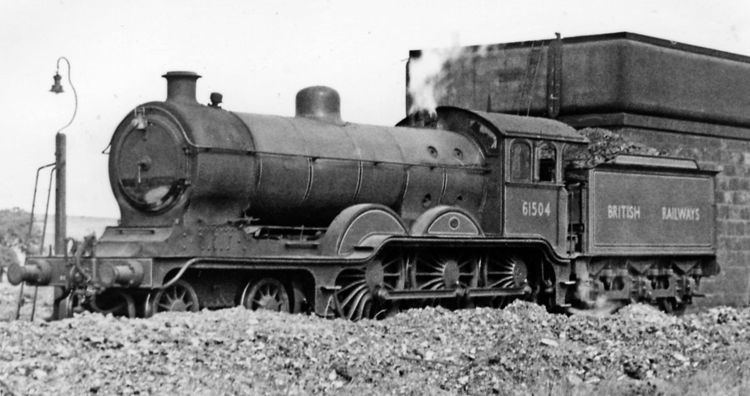Power type Steam Build date 1911–1928 | Designer S. D. Holden Total produced 81 | |
 | ||
Serial number WB 135–154,BP 6487–6496 | ||
The Great Eastern Railway (GER) Class S69, also known as 1500 Class, and later classified B12 by the London and North Eastern Railway (LNER) is a class of 4-6-0 steam locomotive designed to haul express passenger trains from London Liverpool Street station along the Great Eastern Main Line. Originally they were designed by S. D. Holden, but were much rebuilt, resulting in several subclasses.
Contents
Seventy-one S69 locomotives were built by the GER between 1911 and 1921 and numbered 1500–1570. A further 10 locomotives were built by Beyer, Peacock & Co for the LNER in 1928 and numbered 8571–8580. From 1948 the British Railways numbers were 61500–61580 (with gaps).
Background
At the time of their introduction, the "Claud Hamilton" 4-4-0s were becoming outclassed on the heaviest express. Although an enlarged 4-4-0 design was mooted, it was realised that any such design would have too high an axle load for the tracks of the Great Eastern Railway, which had a relatively low restriction. Another design constraint was the short turntables used at the time. This meant that a 4-6-0 design was decided upon, although the design was relatively short compared to similar designs introduced at the same time.
Seventy were still in service at the 1923 grouping, the LNER adding 7000 to the numbers of nearly all the ex-Great Eastern locomotives, including the Class S69 locomotives. A further ten were ordered in 1928 to ease a power shortage caused by the stalled development on a new class of 4-6-0 locomotives, and the cancellation of the planned suburban 2-6-4T tank locomotive due to the adverse press publicity caused by the Sevenoaks derailment.
All the B12 locomotives were fitted with vacuum ejectors between 1924 and 1929 (the 1928 batch had them from new). Fifty-five locomotives were fitted with ACFI feedwater heaters between 1927 and 1934, but these were removed between 1934 and 1942. The first substantive change was the fitting of Lenz poppet valves to the 1928 batch (from new), and six of the ex-GE locomotives (8516/19/25/32/33/40). These locomotives were then classified as class B12/2. The poppet valves were not a great success and they all reverted to piston valve engines between 1931 and 1934.
As newer power became available, the locomotives’ low axleload made them ideal candidates for transfers elsewhere. consequently, between 1931 and 1942, twenty-five locomotives were transferred to Scotland for use on the former Great North of Scotland Railway lines.
Starting in 1932, a programme of rebuilding the B12 locomotives with larger diameter boilers. The Diagram 99A boilers utilised were 5-foot-6-inch (1,676 mm) diameter, compared with the 5-foot-1 1⁄8-inch (1,553 mm) diameter originals. These rebuilt locomotives were classified as class B12/3, and as they had a higher axleload, none of the Scottish-allocated locomotives were included. The last to be rebuilt was 8549 in 1944, leaving 8534 as the last English B12/1; but it was withdrawn the following year without being rebuilt.
As the Scottish locomotive also required new boilers, a new design was started in 1941, based on the old design but with a round-topped firebox and other detail changes. Thirty of these Diagram 25A boilers were manufactured at Doncaster and Stratford between 1942 and 1946. Nine were sent to Inverurie Works for fitting to B12 locomotives, the remainder went to Stratford for fitting to class J20 locomotives. The B12 locomotives fitted with the Diagram 25A boiler (1500/04/05/07/08/11/24/26) were classified as class B12/4.
In the 1942 LNER renumbering scheme, the class was allocated the range 7415–7494, but only eleven (7426/37/49/67/70/72/76/79/82/88/91) were renumbered before the scheme was abandoned due to the war. In the 1946 scheme, the class was allocated the 1500–1580 block, with gaps for the two withdrawn locomotives.
At nationalisation in 1948, seventy-two locomotives passed to British Railways, who renumbered them 61500–61580. Withdrawals continued, and all were gone by then end of 1961.
Accidents and incidents
Preservation & Modelling
One B12/3, LNER number 8572 (BR 61572), has survived to preservation on the North Norfolk Railway, the only British inside cylinder 4-6-0 to be preserved.
A model of the B12 was brought out in OO gauge by Tri-ang Railways (now Hornby) in 1963. Models produced since 1970 feature a steam "chuff" effect, where in the tender as the wheels turn, a piece of sandpaper is scraped by a piece of metal fixed to one axle. In 2016/16 hornby re-released the model in a super detail form without the "chuff" effect. these models are available in LNER apple green and BR lined black with early and late crests [1]
